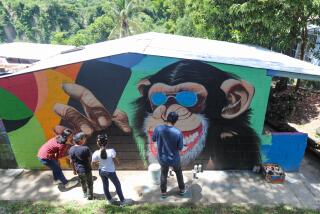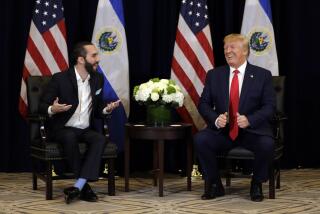Obama visits grave of slain Salvadoran archbishop
Reporting from San Salvador â El Salvador, the tiniest nation in Central America, has plenty of its own problems. Violent gangs. Drug traffickers. An addiction to monies sent from roughly a third of its population living in the United States. Sky-high murder rates.
All of that, however, was overshadowed by other faraway trouble as President Obama spent his first day in El Salvador, the last stop on his five-day, three-nation Latin America tour â which, the White House announced Tuesday, he was cutting short to attend to the crisis in Libya.
Still, Obama completed here (after much delay and out of view of the public) what could arguably have been the most dramatic gesture of his swing through Brazil, Chile and El Salvador: The U.S. leader Tuesday evening made a pilgrimage to the crypt of Salvadoran Archbishop Oscar Romero.
Revered in much of the region, the cleric was slain in 1980 by death squads working for the side in El Salvadorâs civil war that the U.S. government came to support against leftist guerrillas.
On the first visit by a U.S. president to Romeroâs tomb, Obama was accompanied by Salvadoran President Mauricio Funes, elected in 2009 as the candidate representing those guerrillas, now recast as a political party.
Housed in a rather austere lower chamber of the Metropolitan Cathedral, Romeroâs tomb is a frequent shrine of prayer and supplication for Salvadorans and other faithful from around the world.
Obama appeared solemn and lighted a candle alongside the tomb, as did Funes, who paused and crossed himself.
Although many see Romero as a priest deserving of sainthood, his enemies see him as a political figure and tool of the left. His is a figure that in many ways encapsulates still-simmering tensions of the civil war that ended by United Nations-brokered peace accords 20 years ago.
There were no cheering crowds or religious processions in the streets to greet Obama. Security was so tight that the entire area around the cathedral was emptied of the usual cacophony of street vendors and smoke-belching buses, replaced by hundreds of police and army troops, four armored personnel carriers, sharpshooters and sniffer dogs.
âHow wonderful it is that President Obama comes to see our pastor!â said Marco Tulio Ramirez, 50, a clothes peddler who fought in the war and was one of several hundred people kept blocks away from the cathedral but who still hoped to catch a glimpse of the president.
âMsgr. Romero was never a communist. He was a man who died like a sheep among the wolves.â
In an interview with The Times shortly before Obamaâs arrival in San Salvador earlier Tuesday, Funes said he did not think Romero remained a polarizing figure for Salvadoran society.
âMsgr. Romero has transcended ideology and is the nationâs spiritual guide,â said Funes, who has a portrait of the bishop in his presidential office. Homage from as important a world leader as Obama only validates that, he said.
Romero, at the time his nationâs most senior religious figure, was assassinated by a sniper as he said Mass at a chapel in Divine Providence Hospital in San Salvador on March 24, 1980. He did not support the guerrillas and condemned violence from all sides.
But increasingly his sermons demanding justice for the poor and an end to the military repression of the day were seen as a threat by powerful right-wing forces.
Romeroâs murder was ordered by former army Maj. Roberto DâAubuisson, considered the father of death squads that terrorized dissidents and leftist sympathizers, according to the 1993 Truth Commission, assigned by the U.N. to get to the bottom of some of the most egregious atrocities committed by both sides during the war.
DâAubuisson, who died of cancer in 1992, also founded the Arena political party, which ruled El Salvador uninterrupted from the late 1980s until the election in 2009 of Funes and the Farabundo Marti National Liberation Front of former guerrillas.
Through the war, U.S. administrations staunchly supported Salvadoran governments, including that of Arena, in the fight against the guerrillas, pouring in billions of dollars in aid, military supplies and advisors.
To this day, diehard supporters of DâAubuisson defend his role in the war.
Aside from some grumbling, most of Arena has not publicly criticized the Obama visit.
The visit to the crypt, after a tour of the cathedral, almost did not happen because of crises thousands of miles away that continued to dominate and distract from Obamaâs first visit to this part of Latin America. The White House said Obama would cut short the trip, returning to Washington a few hours early.
From the beginning, Obama has juggled his dual responsibilities as head of state and commander in chief. It has made for some awkward moments. His announcement that the U.S. would take part in attacks on Libya was made at a convention center in Brasilia, the Brazilian capital, on Saturday, after a meeting with business leaders. And at a gala dinner in Chile on Monday, he watched a dance performance even as he dealt with the first crisis of the 2-day-old conflict: the crash of a U.S. fighter jet.
Obama had been scheduled to tour Maya ruins outside San Salvador on Wednesday. Instead, he will take part in a secure conference call with national security aides about the conflict in Libya. Had he spent the day sightseeing, Obama would have run a risk of looking detached from a Libyan conflict in which Americans are in danger.
Funes said Obamaâs visit was an important recognition of El Salvadorâs âhistoricâ democratic transition â a right-wing party that governed for nearly two decades handed power peacefully to a leftist coalition of former guerrillas after elections in 2009 â and its struggle to build a new economic model less dependent on remittances.
The two leaders said they would unite in efforts to combat organized crime and agreed that social programs, including education and jobs, were necessary to remove what Funes called the âfertile fieldâ of recruits for gangs.
âWe canât continue offering our youths, here and in all Central America, two paths: head north [to the U.S.] or join a criminal gang,â Funes said.
More to Read
Get the L.A. Times Politics newsletter
Deeply reported insights into legislation, politics and policy from Sacramento, Washington and beyond. In your inbox three times per week.
You may occasionally receive promotional content from the Los Angeles Times.











